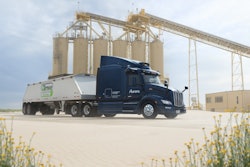Intermec Technologies (www.intermec.com) announced that its rugged 761 handheld computer is approved to operate on the Verizon Wireless network for voice and data transmission.
Manhattan Associates (www.manh.com) announced that USF Glen Moore, a provider of customized truckload van services, purchased Manhattan Associates’ Profitability Suite to help determine the long-term value of each lane and customer in its network.
Getloaded.com enhanced its Internet Load Board with a color-coded Load Availability Map that shows states with the highest potential according to availability of loads – high, medium and low – based on the ratio of inbound to outbound loads, and the ratio of loads to truck postings.
GE Equipment Services (www.trailerservices.com) and TMW Systems (www.tmwsystems.com) have agreed to integrate GE’s VeriWise Asset Intelligence system – a trailer tracking technology – with the dispatch module of TMW Systems trucking software.
TransCore (www.transcore.com) said it will use its research-and-development investment in its satellite-based modem for its GlobalWave asset tracking system to introduce a combined dedicated short-range communications and long-range GPS and satellite communications modem for automobile safety products. The blend of technologies will allow automakers to deliver integrated systems such as automated warnings and collision avoidance for fire, ambulance and police response.
It is common for carriers, particularly those in the less-than-truckload (LTL) sector, to handle shipments that arrive with inaccurate weights on the bill of lading. Usually, an inaccurate weight is simply an accounting error or incorrect estimate. Sometimes it may be intentional.
LTL carriers generally calculate freight rates on 100-pound increments or “hundredweights.” Catching mistakes of 100 pounds or more is a significant revenue source for those that have a “re-weigh” system to document weight discrepancies and adjust invoices for hundreds – even thousands – of shipments each day during transit.
Some fleets are using information systems to capture weight exceptions automatically, thereby increasing their revenues with minimal effort and investment. After all, not everything in trucking has to be a low-margin business.
Benton Express, a 350-truck LTL carrier that operates in the Southeast, uses lift trucks equipped with digital scales in its larger terminals. The scales display the weight of a pallet or skid to dock workers as they cross-dock the freight. If a worker spots a discrepancy between the scal and the printed or written weight on the BOL, he fills out a re-weigh certificate on the spot, says Mark Headrick, the company’s director of information technology.
The dock worker takes the certificate into the office, where it is entered into a custom software system that adjusts the customer’s invoice accordingly. Re-weigh certificates are made available to customers via the website or through instant fax, Headrick says.
Terminal managers and the corporate office also use the software system to track monthly and annual weight inspection goals. “I don’t know what the revenue benefit is, but I know it is substantial enough to be one of our key operating indicators,” Headrick says.
Recently, two large LTL carriers have taken their re-weigh system to the next level of automation by using wireless technologies and mobile computers. These carriers – which both preferred to not be identified until they complete their rollout – are using lift truck scales that communicate wirelessly with vehicle-mounted Intermec mobile computers, says Kevin Moore, Intermec’s senior business development manager for transportation and logistics.
The Intermec computers are linked wirelessly to a local area network. When a shipment arrives at a terminal, a dock worker scans a barcode on the BOL that identifies the shipment. Through the local area network, the computer is updated and displays information for the lift truck operator, such as the shipment origin, destination, dock door and, finally, the trailer where it will be loaded.
The computer also tells the lift truck operator the number of pallets/skids and weight of the shipment, according to the BOL. The onboard scale registers the actual weight and, through wireless connection to the Intermec computer, displays that weight on the computer; the driver then accepts the BOL weight or adjusts the weight accordingly, Moore says. If the weight is adjusted up or down, the invoice is updated in the system in real time and sent to the customer with the adjusted charge.
Although weighing freight in transit is not a new practice, automating the process with mobile computing and wireless communications is an example of how carriers are increasing their margins without touching their rates – or even a piece of paper.
AirIQ adds Cingular
AirIQ (www.airiq.com) announced a data resale agreement with Cingular Wireless, the largest wireless carrier in the United States, and the launch of a digital wireless solution for its location-based services. Certain versions of AirIQ products and services are available now on the Cingular nationwide GSM/GPRS network, with all further terrestrial products – including a trailer-tracking module – available by the start of 2006. AirIQ clients will benefit from the ability to send and receive more information, measured in both frequency and volume, the company says.










